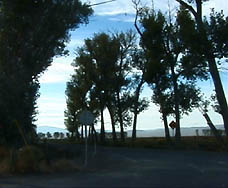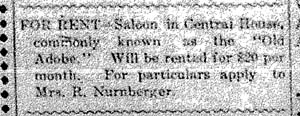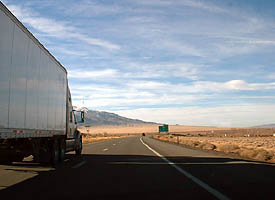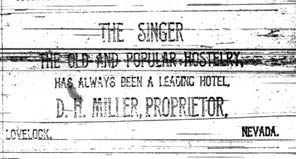
It was evening when we pulled off the freeway to head into Lovelock, Nevada. The last of the sunlight left the mountains to the east as we slowed along the off ramp.
Lovelock was never a town we would go to for a vacation, just a town we would stop on our way to someplace else. This time we planned to stay. And I was excited about having time in Lovelock, the town Chaplin’s leading lady Edna Purviance called home. I had spent months studying the history of Lovelock, reading the historical newspapers, official court documents and studying photos and maps of the town. By the time we drove into Lovelock, I was armed with information about the Purviance family, the business they owned and the town in which they lived. What I didn’t have on that early fall evening, was much about the history of the property, and most intriguing, whether the Purviance home still existed and what it looked like. At the top of my wish list, I wanted a photograph of the place Edna called home. |
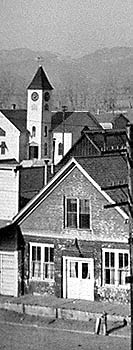 |
Lovelock Home The story of Edna Purviance’s Lovelock Home Research by Linda Wada © - October 21, 2004 Editing - Wes Wada Part One - Early History I have a scattering of old photos that depict the town. One particular photo show the Lovelock of 1910, but the image I have is only a small photocopy. I wanted to find the original photo because I knew Edna’s home was likely in that photo. But where would I find it? As we drove into Lovelock that evening, I could see that the town had gone though many changes. There were empty lots where businesses once stood. A few businesses were closed down, and a few new ones were dotted about. We passed a white church, which looked newly painted and ready for services. The church was at 10th and Cordell St. We were only two blocks from the Purviance home! |
One block further, we turned right on 9th and Cordell. One block east, we arrived at the corner of 9th and Broadway, and pulled to stop by an old tree. A single sign on one of the buildings jumped up out like a beacon as we passed: B&R Plumbing Shop.
We looked at the lot to the left of shop, where there was a single story cinderblock building with wood sliding doors. To the left of this building was a barren strip of land that was weeded over and might have been a garden at one time, for it had a wire fence around it. The building at right angle to the barren garden space also displayed a sign.
Over the years, The Up To Date Laundry had been incorrectly identified by a few as being Edna’s old home, but I knew from the information I gathered that the laundry building wasn’t Edna’s old home. It never fit any of the descriptions I had gathered, and the location was too far from 9th Street. This laundry building was clearly on a different lot, but the newer cinderblock addition jutted into what I thought was the Purviance property. What I really needed to find was a copy of the original 1910 photo and to search the records to see what had happened. I also needed to measure to get a sense of the lot boundaries, and to see how much the laundry building extended into the hotel lot. My main question was answered. Edna’s home was no more. But, lots of exciting new questions arose on that first night, including the newest one. What had happened to Edna’s home? The next morning we took advantage of the good morning light and photographed the property. We also talked to a few friendly local residents who passed and asked what we were doing. Soon, it was time to head for the county courthouse. In Edna’s day, the county courthouse was not in Lovelock. At that time legal matters were transacted 70 miles away in the Humboldt County Courthouse in Winnemucca. In early 1919, Lovelock decided to create its own county separate from Humboldt County. I even found a member of Edna's family active in the group. To mark their new independence, they commissioned the first and only round courthouse built in the United States. The structure is impressive, and we were given a tour. Inside were old photos, and we looked at every one, but no pictures there helped in my search for Edna’s old home. We thank them, and headed to the county recorders office. When the new county was created, records were split between Humboldt and Pershing County. I found out in my research that Lovelock records before 1920 are located in the Humboldt County Courthouse in Winnemucca, and the records from 1920 to present are located in the Pershing County Courthouse in Lovelock. Records from 1919, the year of the split, I actually found a bit scattered between both courthouses.
On the records office wall was the large 1910 panoramic photo of the west side of Railroad Street. The print was professionally shot in 1910 by noted Reno photographer Mr. Dann. The town’s people knew the photo was being taken, for they were standing outside the storefronts looking up at the photographer perched high on a rooftop on the east side of the railroad tracks. Quite likely Edna knew some of those people appearing in the photograph. A few could have been Edna’s relatives as she had extensive family in Lovelock. The print was rich in detail and had excellent sharpest. Edna’s home and business had many names over the years, so with my list in hand, I scoured the photograph to find a familiar name. And there it was. On a tilting narrow white sign, peeking from behind a telegraph pole, the words ‘Central House’.
We also studied the building next to it, and it was called the French Laundry in 1910. And it looked striking similar to the building currently at that location. After seeing the current vacant lot, that laundry building’s history seemed to hold the key to the fate of the Purviance home. I also needed to see if that current laundry building was a direct descendent of the French Laundry building of 1910. But my second question was answered! I now knew actually what Edna's Lovelock home looked like. I continued research in Lovelock, Winnemucca and Paradise Valley on that trip, and made a return journey to Lovelock to accurately measure the lots and to find more answers to questions the first trip created. This story is about the place where Edna grew up, and where her mother ran a business for nearly 25 years. I also unearthed a great deal about Edna’s family life in Lovelock, which I will share in future stories about Nevada and her family. |
|
Founding of Lovelock
The meadow early travelers rested became known at the Big Meadow, where the Humboldt River sank into the desert soil. George Lovelock made it his home. He would not be alone in his choice, for many others would make their homes in the area too. But it is George Lovelock’s last name that would be printed on all maps to this day. According to official history, George Lovelock donated about 80 acres of land for the town site to be built along the First Transcontinental Railroad project. The land transformed from desert and meadow to the township of Lovelock, Nevada. Lovelock was laid out in a grid with lots sized 25 feet wide by 130 feet deep along both sides of the railroad tracks. The other city lots were 50 feet wide by 135 feet deep. It is reported that proceeds from the sale of these lots were used to help pay for the building of the railroad. With the railroad, life was easier, with supplies all over the world arriving by train. It also brought in more people from all over the world. Lots did sell, but maybe not as fast in every town as the railroad would have liked. In 1883, many bare lots were still available along Railroad Street in Lovelock when a Frenchman and his wife decided to purchase. George Singer, from France, was an early settler in the Big Meadow area too. He became a good friend of George Lovelock. Singer actively purchased property along Railroad Street and other parts of Lovelock. Corner Lot 18 in City Block 14 was one of his earliest buys. It appears to have been barren at the time, for I have not found evidence of a structure on the lot at the time of purchase.
In 1884, Singer and his wife Elizabeth applied for homesteader’s rights on Lot 18 that they were granted from the state of Nevada. The first mention of a building on the property appears in the official tax records of 1884 in the name of the Adobe House. |
|
A Property Called Singer
It would be months later, when a new proprietor announced The Singer Hotel open for business… |
Back to Top
All other content Copyright 2003-2016 - Edna Purviance, ednapurviance.org Research Collection
Linda Wada, WadaWorks, All Rights Reserved
including photos and newspaper articles from public and private collections.
Special thanks to the official county offices and libraries from Humboldt and Perishing County.
